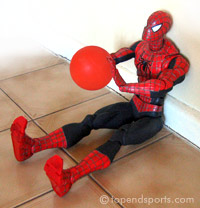|
|
Seated Medicine Ball ThrowThis test is also called the medicine ball chest pass, and there is a similar test using a powerball: the Powerball Chest Launch. The following information describes the procedures as used for the NHL pre-draft testing combine.
 - aim: This test measures upper body (arm) strength and explosive power. By keeping the back in contact with the wall the strength of the arms only are tested.
- equipment required: 4 kg (~ 8 lb) medicine ball, wall, tape measure
- procedure: The athlete sits on the floor with his legs fully extended, feet 24 inches (~60 cm) apart and the back against a wall. The ball is held with the hands on the side and slightly behind the center and back against the centre of the chest. The forearms are positioned parallel to the ground. The athlete throws the medicine ball vigorously as far straight forward as he can while maintaining the back against the wall. The distance thrown is recorded.
- scoring: The distance from the wall to where the ball lands is recorded. The measurement is recorded to the nearest centimeter (other protocols have used the nearest 0.5 foot or 10 cm). The best result of three throws is used.
- variations: 1-2 kg medicine balls are used too, depending on the abilities of the subjects being testing. The weight of the medicine ball will obviously affect results, and should be selected to best test the age group or abilities of your subjects. There is also a similar test using a powerball: the Powerball Chest Launch. The seated medicine ball toss can also be done with the subject facing the other way and throwing the ball over their head for maximum distance. The test can also be performed without a wall, so that the torso can also be used to help propel the ball. See also other medicine ball throw tests.
- target population: This protocol is as used for the NHL, though this test would be suitable for any sports in which upper body strength is important, such as rowing, tennis.
- advantages: this test is easy and quick to perform for an individual.
- disadvantages: several people are needed to conduct this test smoothly: one to mark results, another to check technique and another to collect and return the balls. If testing a large group, it can be time consuming to put all the subjects through this test.
- comments: The angle the ball is thrown is important. You may want to explain to the subject about the optimal angle for maximal distance, and to allow some practice attempts. You may aid in the ease of measurement for this test by extending a tape measure out along the expected path in front of the subject. When recording the distance, you can either move the tape to where the ball landed, or less accurately align where the ball landed to the approximate distance on the tape.
Related Pages
 该贴已经同步到 songyan的微博 该贴已经同步到 songyan的微博 |
评分
-
查看全部评分
|
 |小黑屋|手机版Mobile|体能论坛
( 粤ICP备15092216号-2 )
|小黑屋|手机版Mobile|体能论坛
( 粤ICP备15092216号-2 )